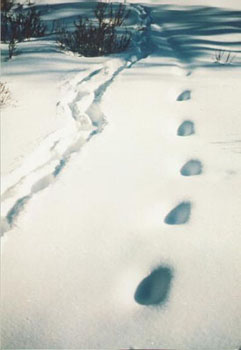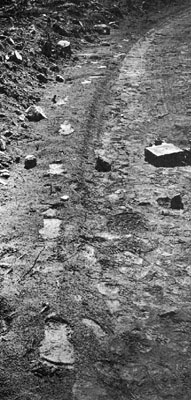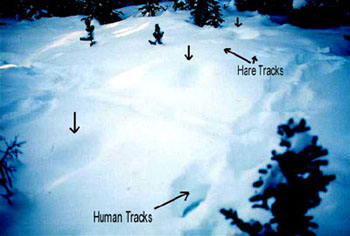
 |
|
| Main Page | State by State sightings |
Track Evaluation Report
|
 |
| Photo #1 |
Analysis of Track Photos
| Reference photo: note lack of much straddle or toe-out |
 |
Photo #1 shows a line of depressions approximately 18" to 24"
in length that apparently represent individual tracks in snow that had
been heavily snowed on after the tracks were made. There is not much apparent
straddle to the tracks, and they appear to be made by a biped. Though
there is not much straddle, there is enough to distinguish what is likely
a left, right, left arrangement. (Note: very little straddle and little
or no toe out "angle of gait" are known sasquatch track line
signatures in most documented cases. See reference photo.) Human tracks
can be compared in Photo #1, as the informant's own tracks are on the
left side of the photo. All known large animal species in that particular
area are quadruped and leave tracks with much foot drag in a deep snow
situation as seen at the site, usually apparent as two parallel lines
of snow disturbance. The only other option for the tracks as photographed
at the scene would be a small bounding animal such as a hare or a bobcat
making each depression as it bounded from spot to spot through the deep
snow. This "small animal" scenario is made unlikely as each
track seems to proceed left, right, left, throughout the track line, distances
are uniformly maintained, and the tracks seem to go around brushy cover
in the photo rather than from cover to cover as is common with small mammals.
He also stated that the tracks maintained uniformity throughout the 1500
feet that he followed them. Each depression is also much deeper than expected
for a small bounding animal.
 |
| Photo #2 |
Conclusion of Analysis
I know of no known animal that leaves tracks like these except for a human, and I know of no known human that leaves tracks this large or with a step this long in such varying conditions. I do not believe that a small bounding animal could leave such a uniform track line for such a long distance. Moose or other smaller ungulates would have left more evidence of foot drag, more straddle and less stride distance in any track line in such conditions. Bears leave very much straddle in any track line in such deep snow conditions and they would look more like the tracks left by the witness as seen in the photo. Because each track is only a depression that had been snowed on, no exact determination of the source of the tracks themselves can be made. However, the signatures of little straddle, extremely large stride, the size of each depression, high step indications, the uniformity of deposition in a left-right sequence, and comparisons to other known Colorado animal tracks make these tracks match that of sasquatch and no other animal or human. If sasquatch is real, and living in that area, I would definitely equate the tracks found as those of a large sasquatch with feet probably over 18 inches long.
Added Note: The area where the tracks were found has had many reported sightings of sasquatch, and the nearby "Monkey Creek" is assumed to have been named that because of historical sightings in that area. Some of the "bigfoot" sightings in the Pike National Forest and Lost Creek Wilderness have been by outdoor professionals (3 different hunting guides) and most all of the sightings have been made in daylight conditions by multiple witnesses. Other tracks like these in snow have also been reported numerous times in the past in the Pike National Forest, as would be expected if sasquatch were real and living in that area. This particular area would be a good area for winter tracking of a sasquatch to the source, as odds of finding tracks in snow there are fairly good. A helicopter or tracking relay team with communication equipment and snowmobiles might be required because of terrain and distances involved.
(The informant sent a request to Bigfoot Encounters for anonymity
on 1/25/04, but is on file in the database)
Initial investigator: Keith Foster
with permission
Updated by Bobbie Short January 28, 2004